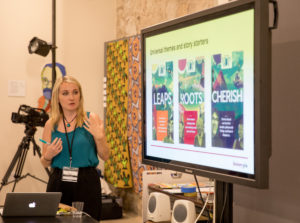By Louise Cooper, Senior Service Designer
Bringing people together to share stories and experiences with one another is the core of what we do at Historypin. We do this so people from different groups can identify their commonalities and build empathy. In other words, we create the conditions to form strong human connections. It’s the fast-track to a more cohesive and resilient community. And it is also fun!
In fact, we want it to be welcoming, thought provoking, inspiring – and even magical.
It’s the people who come to share stories at Historypin events who we’ve put at the centre of our design process. Through our first cycle of human-centred research and design work to co-create the future of storytelling, we developed a new kit for 
running once-off story sharing events. We’re calling it Historypin’s Storybox. Now, we’re expanding our thinking to design and test a 6 week programme of events that can build deeper connection.
As we rapidly progress, we use three design principles that underpin the work we do and continually keep our focus human-centred.
Principle #1 – Universal story themes

Historypin’s Storybox starts with eliciting personal stories from people by using themed story prompts.
We believe that every person should be able to share a story, so the theme should always be universal and inclusive in nature. E.g. Share stories about love but not marriage, because not every person has been (let alone want to or be able to).
Principle #2 – A story-first approach
There should be no barriers to contributing a story for anyone. This means that events are not necessarily led by historical photo collections (because not all participants will relate to those photos), and they’re not led by an organisation-centric desire for digital archiving. Because we first and foremost want to bring people together. The rest, if appropriate, can come later.
Thus, we always use story prompts that encourage people to tell stories that matter to them.
Principle #3 – A hub and spoke model

To truly uncover stories that reflect the diversity of the people in a community, you need leave the building and go to where they are. This means that all the events we design must be self-contained and portable so they can be run at several community locations (the spokes), while having a central location to showcase stories and bring those people back together (the hub).
This is the hardest part and the latest of our design principles. We’ll be testing and refining this principle on our Knight “Our Story” Rural Libraries project from October this year. We’ll let you know how it goes.
If you’re interested in hearing more about Historypin’s Storybox or want to share your ideas with us, we’d love to collaborate. Get in touch – and be sure to follow @historypin